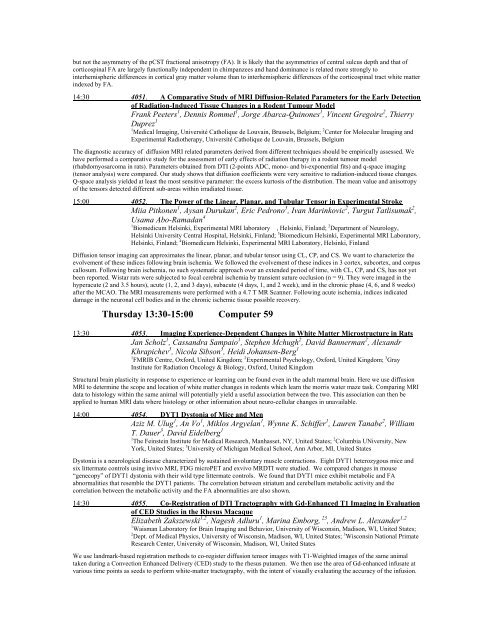ELECTRONIC POSTER - ismrm
ELECTRONIC POSTER - ismrm
ELECTRONIC POSTER - ismrm
Create successful ePaper yourself
Turn your PDF publications into a flip-book with our unique Google optimized e-Paper software.
ut not the asymmetry of the pCST fractional anisotropy (FA). It is likely that the asymmetries of central sulcus depth and that of<br />
corticospinal FA are largely functionally independent in chimpanzees and hand dominance is related more strongly to<br />
interhemispheric differences in cortical gray matter volume than to interhemispheric differences of the corticospinal tract white matter<br />
indexed by FA.<br />
14:30 4051. A Comparative Study of MRI Diffusion-Related Parameters for the Early Detection<br />
of Radiation-Induced Tissue Changes in a Rodent Tumour Model<br />
Frank Peeters 1 , Dennis Rommel 1 , Jorge Abarca-Quinones 1 , Vincent Gregoire 2 , Thierry<br />
Duprez 1<br />
1 Medical Imaging, Université Catholique de Louvain, Brussels, Belgium; 2 Center for Molecular Imaging and<br />
Experimental Radiotherapy, Université Catholique de Louvain, Brussels, Belgium<br />
The diagnostic accuracy of diffusion MRI related parameters derived from different techniques should be empirically assessed. We<br />
have performed a comparative study for the assessment of early effects of radiation therapy in a rodent tumour model<br />
(rhabdomyosarcoma in rats). Parameters obtained from DTI (2-points ADC, mono- and bi-exponential fits) and q-space imaging<br />
(tensor analysis) were compared. Our study shows that diffusion coefficients were very sensitive to radiation-induced tissue changes.<br />
Q-space analysis yielded at least the most sensitive parameter: the excess kurtosis of the distribution. The mean value and anisotropy<br />
of the tensors detected different sub-areas within irradiated tissue.<br />
15:00 4052. The Power of the Linear, Planar, and Tubular Tensor in Experimental Stroke<br />
Miia Pitkonen 1 , Aysan Durukan 2 , Eric Pedrono 3 , Ivan Marinkovic 2 , Turgut Tatlisumak 2 ,<br />
Usama Abo-Ramadan 4<br />
1 Biomedicum Helsinki, Experimental MRI laboratory , Helsinki, Finland; 2 Department of Neurology,<br />
Helsinki University Central Hospital, Helsinki, Finland; 3 Biomedicum Helsinki, Experimental MRI Laboratory,<br />
Helsinki, Finland; 4 Biomedicum Helsinki, Experimental MRI Laboratory, Helsinki, Finland<br />
Diffusion tensor imaging can approximates the linear, planar, and tubular tensor using CL, CP, and CS. We want to characterize the<br />
evolvement of these indices following brain ischemia. We followed the evolvement of these indices in 3 cortex, subcortex, and corpus<br />
callosum. Following brain ischemia, no such systematic approach over an extended period of time, with CL, CP, and CS, has not yet<br />
been reported. Wistar rats were subjected to focal cerebral ischemia by transient suture occlusion (n = 9). They were imaged in the<br />
hyperacute (2 and 3.5 hours), acute (1, 2, and 3 days), subacute (4 days, 1, and 2 week), and in the chronic phase (4, 6, and 8 weeks)<br />
after the MCAO. The MRI measurements were performed with a 4.7 T MR Scanner. Following acute ischemia, indices indicated<br />
damage in the neuronal cell bodies and in the chronic ischemic tissue possible recovery.<br />
Thursday 13:30-15:00 Computer 59<br />
13:30 4053. Imaging Experience-Dependent Changes in White Matter Microstructure in Rats<br />
Jan Scholz 1 , Cassandra Sampaio 1 , Stephen Mchugh 2 , David Bannerman 2 , Alexandr<br />
Khrapichev 3 , Nicola Sibson 3 , Heidi Johansen-Berg 1<br />
1 FMRIB Centre, Oxford, United Kingdom; 2 Experimental Psychology, Oxford, United Kingdom; 3 Gray<br />
Institute for Radiation Oncology & Biology, Oxford, United Kingdom<br />
Structural brain plasticity in response to experience or learning can be found even in the adult mammal brain. Here we use diffusion<br />
MRI to determine the scope and location of white matter changes in rodents which learn the morris water maze task. Comparing MRI<br />
data to histology within the same animal will potentially yield a useful association between the two. This association can then be<br />
applied to human MRI data where histology or other information about neuro-cellular changes in unavailable.<br />
14:00 4054. DYT1 Dystonia of Mice and Men<br />
Aziz M. Ulug 1 , An Vo 1 , Miklos Argyelan 1 , Wynne K. Schiffer 1 , Lauren Tanabe 2 , William<br />
T. Dauer 3 , David Eidelberg 1<br />
1 The Feinstein Institute for Medical Research, Manhasset, NY, United States; 2 Columbia UNiversity, New<br />
York, United States; 3 University of Michigan Medical School, Ann Arbor, MI, United States<br />
Dystonia is a neurological disease characterized by sustained involuntary muscle contractions. Eight DYT1 heterozygous mice and<br />
six littermate controls using invivo MRI, FDG microPET and exvivo MRDTI were studied. We compared changes in mouse<br />
“genecopy” of DYT1 dystonia with their wild type littermate controls. We found that DYT1 mice exhibit metabolic and FA<br />
abnormalities that resemble the DYT1 patients. The correlation between striatum and cerebellum metabolic activity and the<br />
correlation between the metabolic activity and the FA abnormalities are also shown.<br />
14:30 4055. Co-Registration of DTI Tractography with Gd-Enhanced T1 Imaging in Evaluation<br />
of CED Studies in the Rhesus Macaque<br />
Elizabeth Zakszewski 1,2 , Nagesh Adluru 1 , Marina Emborg, 23 , Andrew L. Alexander 1,2<br />
1 Waisman Laboratory for Brain Imaging and Behavior, University of Wisconsin, Madison, WI, United States;<br />
2 Dept. of Medical Physics, University of Wisconsin, Madison, WI, United States; 3 Wisconsin National Primate<br />
Research Center, University of Wisconsin, Madison, WI, United States<br />
We use landmark-based registration methods to co-register diffusion tensor images with T1-Weighted images of the same animal<br />
taken during a Convection Enhanced Delivery (CED) study to the rhesus putamen. We then use the area of Gd-enhanced infusate at<br />
various time points as seeds to perform white-matter tractography, with the intent of visually evaluating the accuracy of the infusion.
















